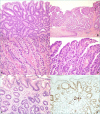Neoplastic and pre-neoplastic lesions of the oesophagus and gastro-oesophageal junction
- PMID: 33179618
- PMCID: PMC7931575
- DOI: 10.32074/1591-951X-164
Neoplastic and pre-neoplastic lesions of the oesophagus and gastro-oesophageal junction
Abstract
Oesophageal and gastro-oesophageal junction (GOJ) neoplasms, and their predisposing conditions, may be encountered by the practicing pathologist both as biopsy samples and as surgical specimens in daily practice. Changes in incidence of oesophageal squamous cell carcinomas (such as a decrease in western countries) and in oesophageal and GOJ adenocarcinomas (such as a sharp increase in western countries) are being reported globally. New modes of treatment have changed our histologic reports as specific aspects must be detailed such as in post endoscopic resections or with regards to post neo-adjuvant therapy tumour regression grades. The main aim of this overview is therefore to provide an up-to-date, easily available and clear diagnostic approach to neoplastic and pre-neoplastic conditions of the oesophagus and GOJ, based on the most recent available guidelines and literature.
Keywords: Barrett’s dysplasia; oesophageal adenocarcinoma; oesophageal dysplasia; oesophageal squamous cell carcinoma; tumour regression grade.
Copyright © 2020 Società Italiana di Anatomia Patologica e Citopatologia Diagnostica, Divisione Italiana della International Academy of Pathology.
Conflict of interest statement
The Authors declare no conflict of interest.
Figures





References
-
- WHO Classification of Tumours of the Digestive System. 5th ed. Geneva: World Health Organization Classification of Tumours. WHO Classification of Tumours Editorial Board. Lyon: IARC press; 2019.
-
- RARECARENet Information Network on Rare Cancers. Accessed: 15 Sept 2019. Available from http://rarecarenet.eu/index.php
-
- Pan Q-J, Roth MJ, Guo H-Q, et al. . Cytologic detection of esophageal squamous cell carcinoma and its precursor lesions using balloon samplers and liquid-based cytologyin asymptomatic adults in Llinxian, China. Acta Cytol 2008;52:14-23. https://doi.org/10.1159/000325430 10.1159/000325430 - DOI - PubMed
-
- Ismail-Beigi F, Horton PF, Pope CE. Histological consequences of gastroesophageal reflux in man. Gastroenterol 1970;58:163-74. - PubMed
-
- Weinstein WM, Bogoch ER, Bowes KL. The normal human esophageal mucosa : a histological rappraisal. Gastroenterol 1975;68:40-4. - PubMed
Publication types
MeSH terms
Supplementary concepts
LinkOut - more resources
Full Text Sources
Medical

